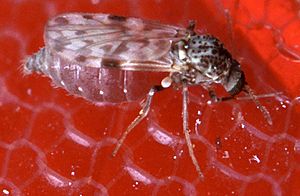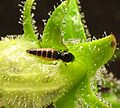Biting midges facts for kids
Quick facts for kids Biting midges |
|
|---|---|
 |
|
| A female biting midge, Culicoides sonorensis | |
| Scientific classification |
|
| Kingdom: | Animalia |
| Phylum: | Arthropoda |
| Class: | Insecta |
| Order: | Diptera |
| Suborder: | Nematocera |
| Infraorder: | Culicomorpha |
| Superfamily: | Chironomoidea |
| Family: | Ceratopogonidae Newman, 1834 |
| Subfamilies and tribes | |
|
|
Biting midges are a family of tiny flies called Ceratopogonidae. You might know them as "no-see-ums" or "sand flies." They are usually only about 1 to 3 millimeters long.
There are over 5,000 different kinds of biting midges around the world. You can find them almost everywhere, except in the very cold Arctic and Antarctic regions. A recent study even found that some midges are important for pollinating cocoa plants!
Contents
Life Cycle of Biting Midges
Like many insects, midges go through four main life stages. This process is called holometabolous development.
The stages are:
- Egg
- Larva (a worm-like stage)
- Pupa (a resting stage)
- Adult (the flying insect)
In warmer places, a midge's entire life cycle can take about two to six weeks.
What Do Midges Eat?
Both male and female adult midges enjoy drinking nectar from flowers. This gives them energy.
Most female midges also need to feed on blood. They get this blood from animals with backbones, like humans. They need the protein from blood to make their eggs.
When a midge bites, it can be painful. The bite often causes very itchy red spots. This happens because your body reacts to the midge's saliva. Midges have special mouthparts that help them cut through skin to get blood.
Some types of midges don't bite animals. Instead, they hunt and eat other small insects.
Where Do Midge Larvae Live?
Midge larvae need a damp place to grow. They also need air and food. They can live in wet soil, mud, or even in water. They are not strictly water-dwellers or land-dwellers.
Midges as Hunters
Some biting midges are known to hunt other small insects. For example, some species in the Bezzia group prey on mosquito larvae. Scientists have studied Bezzia nobilis and found that mosquito larvae are an important food source for them.
Some midges can also be parasites of other insects. They might suck blood from them, which can sometimes even kill their insect hosts.
Midges and Diseases
Like other blood-feeding flies, some Culicoides species can spread germs. These germs can cause diseases in animals.
Some diseases they can spread include:
- Mansonella (a type of tiny worm)
- Bluetongue disease (affects sheep and cattle)
- African horse sickness (affects horses)
- Epizootic hemorrhagic disease (affects deer)
- Certain arboviruses (viruses spread by insects)
How to Deal with Biting Midges
In the past, chemicals like DDT were used to control midge numbers. For example, this was done for Leptoconops torrens in California.
You can try to trap midges by luring them with carbon dioxide. However, most midges are so small that they can easily fly through regular window screens.
To keep them away, you can use insect repellents. Some common repellents contain DEET, oil of Eucalyptus, or Icaridin.
There are also special treatments for midge larvae. Products containing Bacillus thuringiensis israelensis (often called Bti) can kill the larvae.
Types of Biting Midges
Scientists group biting midges into different subfamilies. Each group has unique features.
Leptoconopinae Subfamily
The larvae of Leptoconopinae midges have special head parts and mouthparts that help identify them.
Forcipomyiinae Subfamily
In this group, the larvae have small leg-like parts at both ends of their bodies. These larvae can live on land or in water. They mostly eat algae and fungi. Some species in this subfamily are very important for pollinating tropical plants, like the cocoa bean.
Dasyheleinae Subfamily
Larvae in the Dasyheleinae subfamily have a unique tail end that can pull back into their bodies. These larvae live in water. Interestingly, the adult midges in this group do not feed on animal blood or hunt other insects. They only drink nectar, which is unusual for biting midges.
Ceratopogoninae Subfamily
The larvae of Ceratopogoninae midges are long and do not have leg-like parts or hooks. Most larvae in this group are hunters. Adult females usually feed on the blood of animals or attack other insects. Many females in this subfamily hunt insects that are similar in size to themselves.
The oldest known biting midge is Archiaustroconops besti. It was found in England and lived about 142 million years ago!
Images for kids






